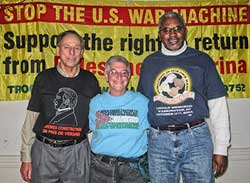Meeting features reports on world struggles
By
Judy Greenspan
San Francisco
Published Oct 29, 2009 8:41 PM
An International Action Center meeting on Oct. 25 featured dynamic eyewitness
reports from three epicenters of struggle—Honduras, Pittsburgh and
Gaza.
|
From left: Dave Welsh, Judy Greenspan
and Clarence Thomas.
WW photo: Brenda Sandburg
|
Dave Welsh, a member of the San Francisco Labor Council and an activist with
the Haiti Action Committee, recently returned from a fact-finding visit to
Honduras with the IAC. Welsh reported that the struggle against the coup and
for the immediate return of President Manuel Zelaya is alive and well.
“The people’s resistance movement is broad and tireless, young and
old, and right up in the face of the police and the army.”
Welsh said the IAC delegation was well-received wherever it went and its
solidarity banner was very popular. “Young people and women are an
important part of the leadership of the resistance movement in Honduras. The
labor movement there is class conscious and at the center of the struggle to
return Zelaya and dismantle the present government, which was responsible for
the coup.”
Welsh described a meeting that the delegation had with a representative from
the U.S. Embassy in Honduras. “It’s clear that the U.S. is
maneuvering to maintain its hold on Honduras and all of the other countries of
the region,” Welsh added.
Clarence Thomas, a leader of the International Longshore Workers Union Local
10, talked about the Sept. 20 National March for Jobs that took place in
Pittsburgh at the beginning of the G-20 summit. Thomas said the march was held
to expose “the face of U.S. imperialism at home.”
Thomas reported that the local and federal governments both worked hard to
prevent demonstrations during the Pittsburgh G-20 summit, a meeting of the
richest countries of the world. It was the hard work of the Bail Out the People
Movement in reaching out to the local communities that enabled the march and
Tent City to happen, according to Thomas.
“The Tent City [organized by BOPM to focus attention on the life and
death issues faced by the workers and oppressed] became a magnet for the
media,” Thomas stated. He added that even a Wall Street Journal reporter
came around to “investigate” the workers’ fight back
movement.
“It was the Bail Out the People Movement that overcame the climate of
fear that the G-20 summit and the government tried to spread,” said
Thomas.
Judy Greenspan, a member of the San Francisco IAC, spoke about her trip to
Palestine this summer with the Viva Palestina U.S.A. Convoy to Gaza. Greenspan,
along with about 250 other activists and supporters, broke through the
U.S.-backed, Israeli-imposed blockade of that embattled city and was able to
spend 24 hours in Gaza delivering medical humanitarian aid.
She described the devastation that the Palestinians suffered last December and
January at the hands of the Israeli military, which intentionally destroyed
much of the infrastructure of Gaza—schools, hospitals, clinics,
government buildings and mosques—in a well-orchestrated terror campaign
against the Palestinian resistance to the Zionist state of Israel.
The IAC representative described the warm welcome that the Viva Palestina
delegation received from the Palestinian authorities and how the government,
with so few resources, was able to organize an unforgettable visit for the
convoy. “Even though we came to Gaza with only one-half of the material
aid that we had purchased, because Egypt confiscated our vehicles, the Gaza
government officials told us that our presence in Palestine was what
counted,” Greenspan explained.
The meeting ended after a lively discussion linking the resistance movement
abroad from Honduras to Palestine with the growing struggles at home against
foreclosures, joblessness and lack of health care.
Articles copyright 1995-2012 Workers World.
Verbatim copying and distribution of this entire article is permitted in any medium without royalty provided this notice is preserved.
Workers World, 55 W. 17 St., NY, NY 10011
Email:
[email protected]
Subscribe
[email protected]
Support independent news
DONATE


